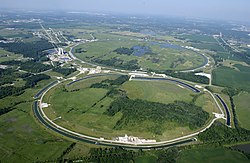Lorentz Force
Paulo Lacombe Spring 2018Template:Electrodynamics

In order to find the force acting on a charged particle inside a magnetic and/or electric field we need to use the Lorentz force rule. When adding a charged particle to a field the field must exert a force on the particle based on the magnitude and direction of the field and the particle.
Because the Lorentz force involves both an electric and magnetic field it is considered part of electromagnetism. Lorentz force also completes the net forces acting on a particle together with other forces such as gravitational force.
Mathematical Model

Complete Formula
- [math]\displaystyle{ \mathbf{F} = q(\mathbf{E} + \mathbf{v} \times \mathbf{B}) }[/math]

F is the force acting on the particle
q is the charge of the particle
E is the electric field
v is the velocity
B is the magnetic field
x is the cross product. In this case the result is the vector cross product between the particle velocity and the magnetic field.
Electric Force
[math]\displaystyle{ \mathbf{F} = q * \mathbf{E} }[/math]
Magnetic Force
[math]\displaystyle{ \mathbf{F} = q(\mathbf{v} \times \mathbf{B}) }[/math]
Analysis

Based on the equation we can conclude that the electric force on the particle is in the same direction as the electric field as long as the particle is positive, the force is in the opposite direction if the particle is negative. The magnetic force will be perpendicular to the velocity and magnetic field, in other words the normal to the magnetic force and the velocity. This force generally causes the particle to move in a spiral as long as the magnetic force is not parallel to the velocity. In that case the force would be equal to zero.
In order to determine the direction of the magnetic force in a physical manner we can use the Right Hand Rule. By placing your four main fingers in the direction of the magnetic field and your thumb in the direction of the velocity, the direction of the force is pointed out of your palm as shown in the diagram.
Example
Problem 1
Find the magnitude and direction of the magnetic force on the antiproton.

[math]\displaystyle{ \vec{v}_p=v\lt 0,-1,0\gt }[/math] [math]\displaystyle{ \hat{r}={\vec{r} \over |r|}={\lt -d,-d,0\gt \over \sqrt{(-d)^2+(-d)^2}}={1 \over \sqrt{2}}\lt -1,-1,0\gt }[/math]
[math]\displaystyle{ \vec{B_p}={\mu_0 \over 4\pi}*{q\vec{v_p}\times\widehat{r} \over r^2}={\mu_0 \over 4\pi}*{e\lt 0,-v,0\gt \times{1\over\sqrt{2}}\lt -1,-1,0\gt \over 2d^2} }[/math]
[math]\displaystyle{ \vec{B_p}={\mu_0ev\over 8\pi\sqrt{2}d^2}*\lt 0,0,-1\gt }[/math]
[math]\displaystyle{ \vec{F_B}={\mu_0ev\over 8\pi\sqrt{2}d^2}*\lt 1,0,0\gt \times\lt 0,0,-1\gt ={\mu_0ev\over 8\pi\sqrt{2}d^2}*\lt 0,1,0\gt }[/math]
History

The Lorentz Force was first derived by Hendrik Lorentz in 1895. It separated the particle from the fields around it putting it into a matter category. This allowed Lorentz to characterize charged particles with both electric and magnetic forces. Even though the Lorentz Force law is an important building block to electromagnetism it cannot account for all electromagnetic phenomenon. For example, it only considers the field acting on a charged particle, ignoring the field created by the particle itself. Therefore, if we were to analyze the forces on a system with both a magnetic and electric field as well as more than one charged particle we would need more equations to calculate the behavior of the charged particles.
One common use of the Lorentz Force law is in particle accelerators. As the name suggest a particle accelerator is an apparatus used to speed up a particle in order to study the behavior of particles in different scenarios. The most famous particle accelerator is the LHC, or large hadron collider in Europe. The LHC uses electromagnetic forces to speed up particles and collide them analyzing the radiation emitted from each collision. Using electromagnetic forces in a loop means that particle accelerators can speed up particles to incredible speeds nearing the speed of light.
See also
The Lorentz Force law was used to derive the Laplace force which considers all moving charges in a wire to show the magnetic force acting on the wire.